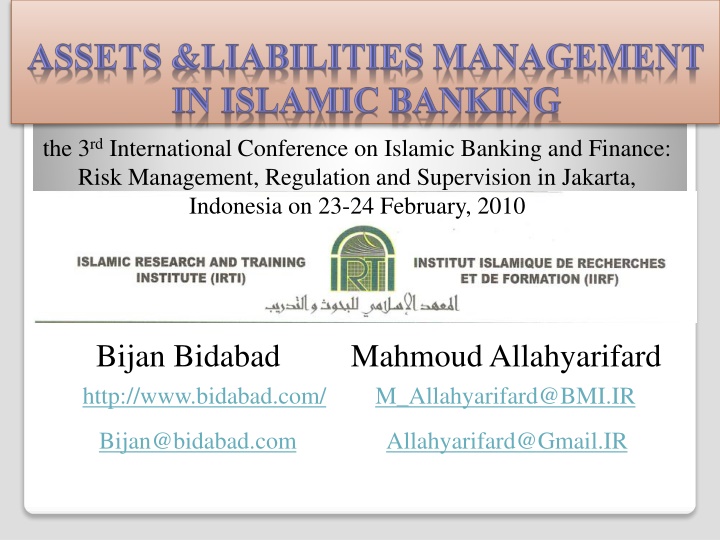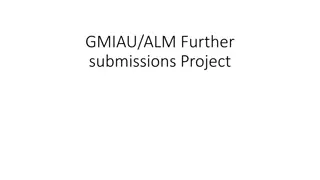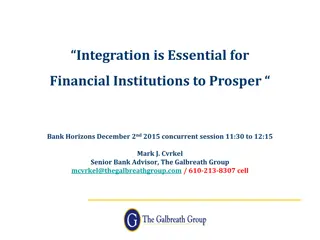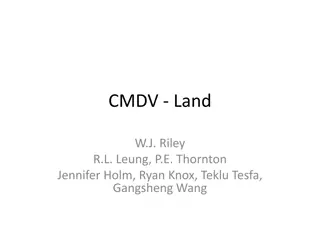
International Conference on Islamic Banking and Finance: Insights and Analysis
Explore the concepts of Islamic banking and finance, including risk management, regulatory frameworks, and asset-liability management. Discover the criteria to distinguish usury from non-usury transactions and the balance sheet structure of Islamic banks. Gain insights into comparative economic value added analysis and the differences between Islamic and conventional banking systems.
Download Presentation

Please find below an Image/Link to download the presentation.
The content on the website is provided AS IS for your information and personal use only. It may not be sold, licensed, or shared on other websites without obtaining consent from the author. If you encounter any issues during the download, it is possible that the publisher has removed the file from their server.
You are allowed to download the files provided on this website for personal or commercial use, subject to the condition that they are used lawfully. All files are the property of their respective owners.
The content on the website is provided AS IS for your information and personal use only. It may not be sold, licensed, or shared on other websites without obtaining consent from the author.
E N D
Presentation Transcript
the 3rdInternational Conference on Islamic Banking and Finance: Risk Management, Regulation and Supervision in Jakarta, Indonesia on 23-24 February, 2010 Bijan Bidabad http://www.bidabad.com/ MahmoudAllahyarifard M_Allahyarifard@BMI.IR Bijan@bidabad.com Allahyarifard@Gmail.IR
Compatibility and incompatibility of economic theories with Islamic banking Criteria to distinguish usuric from non-usuric transactions Assets and liabilities structure in Islamic banking Assets and Liabilities Management (ALM) and risk indices Mathematical Model for Comparative Economic Value Added (EVA) Analysis in both Banking Comparision of Islamic and Conventional Banking Conclusion Q & A.
Probably, one of the usury illegalness reasons in Islamic banking may comes from affection of money market fluctuation on real economic sector that causes economic divergence from long run stability growth and imbalances in money market and other markets as well.
Criteria to distinguish usuric from non-usuric transactions 1. Loaner must share in profit/loss of the economic activity of loanee. 2. The rate of interest must not be determined and conditioned before. 3. Interest in consumption loans is usury. 4. Foreign currency exchange (without interest) is not usury
+ AL ELS (1) = t ELN assets t LR t t : Liquid AL t : : Estimated Estimated acquired liquidity liquidity needs based on liability sources ELS ELN t
Comparative Rate of Return Fluctuations In both Banking Types Rate Time Rate Time
Cost of maintaining liquidity Islamic total cost Conventional total cost Cost Cost of insufficient liquidity in conventional banking Cost of insufficient liquidity in Islamic banking PLS b Con b L* L** Optimum bank liquidity
High liquid Assets: Sukuk, Mousharekah Certificates (PLS), Mousharekah Bound(Oragh- e-moshrehkah) Accounts and Notes receivable: Repurchase of debts (Kharid-e-Dayn) contraction. Financing and advances based on Islamic contracts: Mudarabah & Moshrekah Finacing, Gharzolhasaneh
Total outstanding claims, allowance for bad and doubtful financing of government and non-government claims, debts of paid L/C on the base of Islamic contracts, irrecoverable receivable notes and others are classified in this group. Non- performing Financing Characteristics In Islamic Banking: Decline allowances for bad and doubtful financing because of transferring of a fraction of risk to depositors More transparency on the balance sheet items In case of bankruptcy and investment loss, amounts of investment is directly booked in costs accounts PLS Con
+ 1 2 C C (2) = = CAR RWA
= (3) EVA r K (4) = + (div ) r r E PLS m TR = = TR FDr TC BF (5) PLS+ a (6) = 1 ( ) FD D PLS b (7)
(8) = + TC OC NOC (9) = 1 ( ) OC a b D PLS PLS PLS = + [ 1 ( t ) 1 ( ) ] EVA D a PLS b PLS r BF a PLS b D NOC r K PLS t PLS t t t (10) = + [ 1 ( ) D ] OC a b i (11) Con Con Con = + [ 1 ( t ) 1 ( ) ] EVA D a Con b Con r BF i D a Con b D NOC r K Con t t Con t t t (12) So: EVA EVA (13) PLS Con
Since provident reserve in PLS banking is lesser than conventional banking so financial efficiency in PLS banking is more than conventional banking. The main reason of more efficiency is due to stability in cash flows of PLS banking; so for covering liquidity risk less provident funds are required in comparison with conventional banking. Lack of outstanding claims and doubtful claims in PLS banking because of nature of Musharakah contracts and supervision on investments decline coefficient in Islamic banking in comparison to conventional banking. Hence lack of this kind of inefficient assets will improve financial circulations in PLS banking than conventional banking and this will grow up the EVA in this kind of banking system. Rate of return in PLS banking is more than the conventional banking, so consequently EVA in PLS banking is higher than conventional banking. Con PLS r r PLS b Con b PLS Con
RHB Islamic banking RHB Investment banking 31.03.2007 RM,000 31.12.2006 RM,000 31.03.2007 RM,000 31.12.2006 RM,000 Indices Cash balances with banks and other financial institutions 35177 34147 35035 21283 Total assets 8239971 8092265 72675509 6834756 LiquidAsse ts 43% 26% 48% 50% QR = Assets
RHB Islamic banking RHB Investment banking 31.03.2007 RM,000 31.12.2006 RM,000 31.03.2007 RM,000 31.12.2006 RM,000 Amount % Amount % Amount % Amount % Indices Public 78479 1.78 77059 1.8 13128 1.59 10432 1.38 Specific 12.7 2 49374 1.12 48822 1.14 63724 7.74 96458 Total 127853 2.89 125881 2.95 76852 9.34 106890 14.1 Gross financing and advances or loans and advances, RM,000 4416945 4273454 823234 758173
RHB Islamic banking RHB Investment banking 31.03.2007 % 31.12.2006 % 31.03.2007 % 31.12.2006 % Indices ROA .27 1.07 .159 .96 ROE 3.28 13.25 1.64 9.24 Core capital ratio (including of market risk) Risk-weighted capital ratio (including market risk) 17.36 17.78 18.5 20.29 15.44 15.84 14.6 16.02
Thank YOU Bijan Bidabad MahmoudAllahyarifard http://www.bidabad.com/ M_Allahyarifard@BMI.IR Bijan@bidabad.com





